e and bread. t labour requirement t labour requirement t labour requirement t labour requirement for bread in France, in hours: aiB = 1 ain and France both have 600 hours of labour available. for wine in Britain, in hours: aw = 12 for bread in Britain, in hours: aLB = 3 for wine in France, in hours: aiw = 2 and QB are the quantities of wine and bread produced in Britain. and Q are the quantities produced in France. With wine on the y-axis and bread on the x-axis, draw and label the producti ossibility frontiers for both countries. Label the axes. ow assume there is free trade. On a new diagram, show the world relative s wine, giving world relative price on the y-axis as Pw PB d world relative quantity on the x-axis as Qw + Qw QB+QB
e and bread. t labour requirement t labour requirement t labour requirement t labour requirement for bread in France, in hours: aiB = 1 ain and France both have 600 hours of labour available. for wine in Britain, in hours: aw = 12 for bread in Britain, in hours: aLB = 3 for wine in France, in hours: aiw = 2 and QB are the quantities of wine and bread produced in Britain. and Q are the quantities produced in France. With wine on the y-axis and bread on the x-axis, draw and label the producti ossibility frontiers for both countries. Label the axes. ow assume there is free trade. On a new diagram, show the world relative s wine, giving world relative price on the y-axis as Pw PB d world relative quantity on the x-axis as Qw + Qw QB+QB
Principles of Macroeconomics (MindTap Course List)
8th Edition
ISBN:9781305971509
Author:N. Gregory Mankiw
Publisher:N. Gregory Mankiw
Chapter9: Application: International Trade
Section: Chapter Questions
Problem 10PA
Related questions
Question

Transcribed Image Text:8.
(e)
(f)
Answer ALL parts of this question.
Britain and France are countries in a Ricardian trade model. Each country produces
wine and bread.
Unit labour requirement for wine in Britain, in hours: aw = 12
Unit labour requirement for bread in Britain, in hours: aLB = 3
Unit labour requirement for wine in France, in hours: aiw = 2
Unit labour requirement for bread in France, in hours: aiB = 1
Britain and France both have 600 hours of labour available.
Qw and QB are the quantities of wine and bread produced in Britain.
Qw and Q are the quantities produced in France.
With wine on the y-axis and bread on the x-axis, draw and label the production.
possibility frontiers for both countries. Label the axes.
Now assume there is free trade. On a new diagram, show the world relative supply
of wine, giving world relative price on the y-axis as
Pw
РВ
and world relative quantity on the x-axis as
Qw + Qw
QB +QB
Expert Solution
This question has been solved!
Explore an expertly crafted, step-by-step solution for a thorough understanding of key concepts.
Step by step
Solved in 3 steps with 3 images

Follow-up Questions
Read through expert solutions to related follow-up questions below.
Follow-up Question
Now, please help me with part g and h. Thank you

Transcribed Image Text:(d)
(e)
(f)
(g)
(h)
Under autarky, calculate the relative price of wine in each country.
With wine on the y-axis and bread on the x-axis, draw and label the production
possibility frontiers for both countries. Label the axes.
Now assume there is free trade. On a new diagram, show the world relative supply
of wine, giving world relative price on the y-axis as
Pw
PB
and world relative quantity on the x-axis as
Qw + Qw
QB +QB
Relative world demand is given by:
Dw + Dw
= 6
PB
DB + DB
Pw
where Dw + Dw is world quantity demanded of wine and DB + D is world quantity
demanded of bread. Use the given equation to draw the relative demand curve and
give the equilibrium relative price under free trade.
Redraw the production possibility frontier diagram for France, but now show the
frontier both under autarky and after trade. Under the assumption that consumers in
France want the same mix of both goods as the rest of the world, use the diagram to
illustrate the gains from trade. Explain in words why a country that is more efficient
in producing both goods can still gain from trade.
Solution
Knowledge Booster
Learn more about
Need a deep-dive on the concept behind this application? Look no further. Learn more about this topic, economics and related others by exploring similar questions and additional content below.Recommended textbooks for you

Principles of Macroeconomics (MindTap Course List)
Economics
ISBN:
9781305971509
Author:
N. Gregory Mankiw
Publisher:
Cengage Learning

Principles of Economics, 7th Edition (MindTap Cou…
Economics
ISBN:
9781285165875
Author:
N. Gregory Mankiw
Publisher:
Cengage Learning

Principles of Economics (MindTap Course List)
Economics
ISBN:
9781305585126
Author:
N. Gregory Mankiw
Publisher:
Cengage Learning

Principles of Macroeconomics (MindTap Course List)
Economics
ISBN:
9781305971509
Author:
N. Gregory Mankiw
Publisher:
Cengage Learning

Principles of Economics, 7th Edition (MindTap Cou…
Economics
ISBN:
9781285165875
Author:
N. Gregory Mankiw
Publisher:
Cengage Learning

Principles of Economics (MindTap Course List)
Economics
ISBN:
9781305585126
Author:
N. Gregory Mankiw
Publisher:
Cengage Learning

Principles of Macroeconomics (MindTap Course List)
Economics
ISBN:
9781285165912
Author:
N. Gregory Mankiw
Publisher:
Cengage Learning

Essentials of Economics (MindTap Course List)
Economics
ISBN:
9781337091992
Author:
N. Gregory Mankiw
Publisher:
Cengage Learning

Principles of Economics 2e
Economics
ISBN:
9781947172364
Author:
Steven A. Greenlaw; David Shapiro
Publisher:
OpenStax